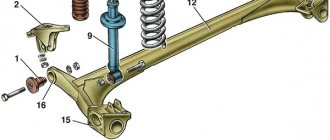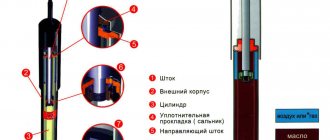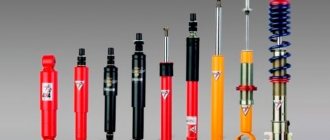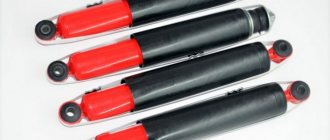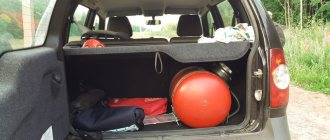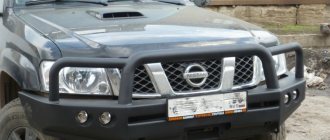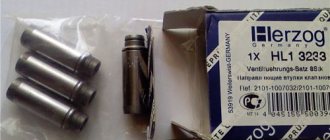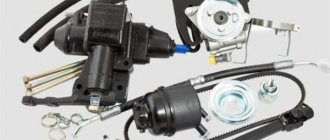Before selecting shock absorbers for the Niva, let’s get acquainted with what they are and what types of these devices exist. The shock absorber is designed to smooth out vertical vibrations, while affecting acceleration and braking dynamics. When accelerating, the car usually “squats” slightly in the rear, while the front wheels receive less load and their contact with the road decreases. When braking, on the contrary, the weight of the car mainly puts pressure on the front wheels. And when turning, the load is redistributed from one side of the car to the other. Therefore, in modern cars, shock absorbers take on the job of maintaining contact with the road, and springs only support the weight of the car.
Structure and types of shock absorbers
Famous Niva
The shock absorber for Niva 21213 or another car has common structural features. In particular, it consists of a solid-vulcanized hinge (rubber plus metal), above which there is a cylinder located between the spring cups in the car suspension. Inside the cylinder there is a seal assembly, a rod immersed in shock-absorbing fluid, and steel discs (compression valve). Under the rod with the discs there is a ring made of high-quality rubber (seal). Even lower is a piston for separating gas and oil, under which there is nitrogen under a pressure of 6 to 12 atmospheres. At the bottom of the cylinder there is an additional bottom welded to its walls.
The cheapest are twin-tube rear shock absorbers (liquid). They consist of two flasks - the inner one, where the piston is located, and the outer one, where excess oil enters during compression. Today they are not in great demand, because this system has a significant drawback in the form of aeration (mixing oil and gas, producing foam, which, unlike oil, is easily compressed). In addition, liquid shock absorbers, due to their double design, are poorly cooled.
Another type of these parts is represented by gas-oil samples. They differ from liquid ones in that instead of air, an inert gas is pumped into them, which acts as a gas boost. The design is considered more reliable, since gas mixes little with oil, but it cannot be installed “upside down,” which reduces its applicability.
Rear shock absorbers for Niva Chevrolet
Last month, PartReview users preferred KYB.
19% of positive votes belong to this manufacturer. Hola shock absorbers took second place - 18%.
The SAAZ company closes the top three with a result of 10% of the votes.
In the general rating of shock absorbers, which takes into account the opinions of owners of different brands and models of cars, these brands occupy the following positions:
- KYB received 8th place, PR score - 76. Data from 293 reviews and 939 votes are taken into account.
- Hola took 5th place, with a PR score of 81. Based on 293 reviews and 286 votes.
- SAAZ is in 18th place, and the PR score is 63. Data from 73 reviews and 236 votes are taken into account.
Car shock absorbers dampen vibrations and absorb shocks and shocks that occur when driving on uneven roads. This ensures comfort and improves wheel grip on the road surface.
Shock absorbers convert the mechanical vibration energy of units connected by elastic elements (torsion bars and springs) into heat. The condition of these parts determines the vehicle's handling and braking distance.
The factory equipment of the Chevrolet Niva provides for the use of products from the Skopinsky Automotive Assembly Plant (SAAZ). Oil shock absorbers from this plant demonstrate good performance characteristics with a calm driving style. Their main advantage is their affordable price. Also for the Chevrolet Niva, gas-oil shock absorbers are produced, in which, in addition to oil, inert gas is pumped. They work out vibrations faster and press the wheels better on the road when cornering and driving along “ridges”.
For drivers who prefer a measured driving style, we can recommend the oil type. They cost 25-30% less than gas-oil ones and provide comfortable and safe driving under normal conditions. Statements about the shorter service life of oil-based devices are not true. Two-pipe oil-filled structures are more difficult to damage, and they remain operational even with partial leakage of the working fluid. Therefore, installing them is a way to save money.
Gas-oil shock absorbers for auto tuning are characterized by increased rebound and compression forces. This makes the suspension stiffer, but the car becomes more stable when cornering at high speed or driving on a washboard. Fans of sporty driving sacrifice comfort, but gain confidence that the shock absorber will cope with the load when driving fast on uneven roads. The gas maintains high pressure of the working fluid and prevents the formation of foam.
Compatible parts are produced by dozens of manufacturers from Russia, Europe, America and China. Let's look at the three most common brands.
1. SAAZ (Skopinsky Automotive Aggregate Plant) is a company that was founded on the basis of an enterprise of the same name. Since the 50s of the last century, the company has been supplying auto parts for VAZ, GAZ and other domestic cars. The products of this company are in high demand, since many Shniv owners try to save money, and the quality of the parts is at an acceptable level.
2. SS20 (Technology System) is another Russian company founded in 1993. This Samara enterprise specializes in the manufacture of steering and suspension parts for Russian cars. Spare parts in the mid-price range are more reliable than SAAZ budget products.
3. KAYABA (Kayaba) is a Japanese company considered one of the best manufacturers of shock absorbers. The price of oil models is slightly different from SS20 products. Expensive gas-filled shock absorbers are specially designed to perform in harsh conditions. They help keep the car on sharp turns and on uneven roads. The quality of the brand is confirmed by the fact that KYB parts are installed on rally cars.
| Manufacturer | vendor code | Installation location | Type | Price, rub |
| SAAZ | 2123-2905402 | front | oil | 1070 |
| 2123-2915402 | rear | 1130 | ||
| 45-2905402-10 | front | gas-oil | 1090 | |
| 45.2915402-10 | rear | 1050 | ||
| KAYABA | 2123-2905004 | front | oil | 2230 |
| 2123-2915004 | rear | 2070 | ||
| 344441 | front | gas-oil | 3950 | |
| 344442 | rear | 4200 | ||
| SS20 | SS20171 | front | oil | 1800 |
| SS20174 | rear | 1900 | ||
| front | gas-oil | 1900 | ||
| rear | 1900 |
Shock absorbers are an integral part of a car’s suspension, the effective operation of which determines not only a comfortable ride, but also traffic safety. At the dawn of the development of the automotive industry, cars were equipped with springs, which made it possible not only to soften road unevenness, but also to dampen vehicle vibrations, keeping it from swaying.
Technological progress has implemented new design solutions that separated the mechanisms of damping and mitigation of dynamic loads. This is how two new units appeared: a spring and a shock absorber. The latter not only creates comfortable driving conditions, but also prevents the car from swaying, ensuring reliable contact with the road, especially when turning.
Shock absorbers with regressive characteristics develop significant forces at a low speed of piston movement in the initial stage of movement. As the speed of its movement increases, the resistance force grows much more slowly. Thus, the regressive characteristics allow you to hold the car well in turns, preventing the car from lateral roll, and also keep the car from longitudinal nods during sharp braking.
However, regressive shock absorbers are very sensitive to unevenness, potholes and other road surface defects. Dampers with progressive characteristics have relatively little resistance at low piston speeds, but as they increase, the force increases quadratically.
Compression should provide the necessary suspension subsidence, preventing it from hitting the body bump stops and creating comfortable driving conditions. At the same time, the rebound parameters should help the wheel roll over uneven surfaces while maintaining full contact with the road. The resistance force during rebound must be significantly higher than during compression, since it is necessary to absorb kinetic energy when the body oscillates.
Also interesting: Replacing a half shaft bearing in a Chevrolet Niva
Almost all domestic cars have shock absorbers of a regression or linear type, which reduce the impact of shock loads on the body. Based on their design characteristics, they can be divided into single-cylinder and double-cylinder. Both of them can be hydraulic, where special types of oil are used as the working fluid. Or gas ones, in which the main damping function is performed by the gaseous medium.
Operating principle of a two-cylinder hydraulic damper.
- Airlock.
- Oil.
- Stock.
- Inner cylinder.
- Bottom eye.
- Top eyelet.
- Top cover.
- Frame.
- Direct and return piston valves.
- Inner cylinder plug with direct and check valves.
- Bottom cover.
Hydraulic or oil shock absorbers are the most common due to their simplicity of design and low manufacturing costs. They have regression characteristics. When driving on uneven roads, the hydraulics behave flawlessly, smoothing out vibration and rolling around bumps.
In oil shock absorbers, the rod is returned to its original position by the suspension spring, and the bumps are bypassed in full contact with the road thanks to soft regressive characteristics.
Gas-oil devices have the same design as hydraulic ones. However, inside there is nitrogen under low pressure, up to 0.5 atmospheres, which acts as a pressure accumulator and prevents aeration. Gas-oil shock absorbers significantly improve the properties of hydraulics and are increasingly used.
The design with one working cylinder is more often used in gas models, see figure.
The operating principle of a single-cylinder gas shock absorber.
- Stock.
- Oil.
- Piston.
- Floating piston.
- Bottom eye.
- Top eyelet.
- Top cover.
- Frame.
- Direct and check piston valve.
- Working gas.
- Bottom cover.
The principle of operation of these devices is as follows: during compression, pressure occurs on the piston 3, which is transmitted through the oil medium 2 to the floating piston 4. The latter is a barrier between the gas 10, located in the housing 8 under high pressure of 15-30 atmospheres, and oil 2, transmitting the pressure from the piston.
The gas shock absorber has a progressive nature of operation, which allows you to effectively operate the car on high-speed roads under heavy loads when cornering, reducing vehicle roll. However, when driving on uneven roads, there will be increased stiffness, reducing driving comfort.
Monotube models: pros and cons
Shock absorber for Niva
You can try to find shock absorbers for the Niva from among the monotube ones, in which there is a piston in one flask, and this is also the body. In such options, gas is pumped under higher pressure (up to 30 atm), they are cooled better, hold the car more accurately, but are more vulnerable to external shocks and temperature changes (the higher the temperature, the greater the gas pressure, the stiffer the suspension). Parts can be placed upside down.
Another type of “one-tube” for the Niva car are shock absorbers with a spring attached and shock absorbers with a remote compensation chamber. The former allow, due to an additional elastic element, to adjust the Niva’s ground clearance (thanks to a screw nut). The remote chamber makes it possible to increase the volume of gas and oil and the working stroke without changing the dimensions, which allows you to fine-tune the operation of the car.
The front and rear shock absorbers on the Niva differ in the method of attaching the upper part, in size, performance characteristics and in the throttle discs at the recoil valve. The front shock absorber has two grooves in the throttle disc in its outer diameter, while the rear shock absorber has three.
Suspension shock absorbers Lada 4×4 (VAZ 2121, 2131) comfort-optima
Compressed state 31cm Maximum uncompressed state 50cm For NIVA 2121; 21213; 21214; 2131 until 2009
Advantages shock absorbers SS20 for Niva car (VAZ 2121):
|
The Niva car (VAZ 2121) has been produced since 1977 and during this time has undergone several modifications. Now the name of the car is Lada 4x4, but its essence, as the most affordable of SUVs, has not changed. Over the years of production, the Niva car (VAZ 2121) has proven itself from the best side, and according to plans, it will live on the assembly line for several more years. However, it has a number of disadvantages. For example, insufficient stability of movement at high speed, bouncing and swaying of the body. These shortcomings are partly explained by the short wheelbase, but the main reason is the standard shock absorbers.
reinforced SS20 shock absorbers on the Niva will allow you to make your car suitable specifically for your operating conditions, and at the same time improve reliability.
The SS20 company offers front and rear reinforced shock absorbers for the Niva , which, unlike the standard shock absorbers of the VAZ 2121, have increased resistance during the rebound stroke, an increased diameter of the body and rod. The increased oil volume in the SS20 shock absorbers for the Niva allows you to move for a long time on rough roads without overheating the shock absorbers and without reducing their performance.
Shock absorbers with “Standard” settings are close in settings to factory shock absorbers, and are suitable for those drivers who are satisfied with the settings of standard shock absorbers. The “Comfort-Optima” modification has increased rebound valve settings, which solves the problem of body sway and significantly reduces “bumping” when the car bounces on uneven roads. Shock absorbers for Niva (VAZ 2121) with “Comfort-Optima” settings are suitable primarily for urban use.
Shock absorbers “Highway” have an even greater rebound force compared to the “Comfort-Optima” series, and in addition, they have increased compression forces, which prevents suspension breakdowns when driving at speed on large bumps. Such settings are suitable primarily for suburban use on roads and moderate off-road conditions.
The highest rebound and compression forces and, accordingly, energy intensity are found in shock absorbers with “Sport” settings. These shock absorbers are suitable for fans of off-road racing, for the most severe operating conditions.
absorbers for Niva (VAZ 2121) have no internal knocks. Also, one of the features of SS20 shock absorbers is their high stability of parameters at low and high temperatures. The body of the SS20 shock absorbers is enlarged compared to standard shock absorbers, which not only allows for an increase in oil volume, but also the use of larger diameter pistons. This significantly reduces the specific loads on the elements of the valve system and increases their service life. Pistons with a “skirt” used in SS20 shock absorbers for Niva (VAZ 2121) provide excellent compaction and stability of shock absorber characteristics with an extended service life. The lower silent block of the front shock absorber has an original design that surpasses the factory one in reliability and damping capacity.
Expensive and cheap options
An exact answer to the question: “Which shock absorbers are better to install?” - does not exist, since each Niva owner has his own driving style and conditions, and the selection of these parts is not always large in Russian stores. The best products are considered to be from KONI, which in Germany have a lifetime warranty for one car under one owner. They need to be tuned frequently (30-40 thousand km). Red part numbers significantly improve ride quality without any loss in handling. The cost of one shock absorber can exceed a hundred dollars.
Popular products for Niva
Parts from American are known for being produced in a single-pipe version, very rigid and of high quality. The cost goes up to $140 each. On Niva you can find a budget option around 30-40 dollars. Shock absorbers from BOGE and SACHS cost about $30-50 (manufactured in Germany) and are considered to be of lesser quality. Two-pipe hydraulic samples from Rancho (USA) with a reinforced chrome-plated rod, a special boot and an all-weather corrugated cover are considered approximately equal in quality to SACHS. Considered less comfortable than SACHS.
For lovers of measured driving on asphalt roads, very inexpensive products from SAAZ may be suitable. The plant produces oil-based twin-pipe shock absorbers with the following standard characteristics:
Rear shock absorbers:
- length when retracted - 31.5 cm;
- stroke 18.15 cm;
- casing diameter - 5 cm;
- upper end - eyelet, 2.55 cm;
- lower end - eyelet, 2.55 cm;
- rebound force 114-146 kg;
- compression force - from 22 to 36 kg.
Front shock absorbers:
- length when retracted - 22 cm;
- stroke 8.35 cm;
- casing diameter - 5 cm;
- upper end - pin, 1.4 cm;
- lower end - eyelet, 2.8 cm;
- rebound force 129-154 kg;
- compression force - from 17 to 31 kg.
TOP manufacturers of shock absorbers for Chevrolet Niva
This spare part for Chevrolet Niva cars is made in different parts of the world. The site contains reviews of shock absorber manufacturers from countries such as Japan, the Netherlands, Russia, South Korea, Belarus.
In March 2020, 7 manufacturers took part in the rating of shock absorbers for the Chevrolet Niva on PartReview. It is built on the basis of 26 reviews and 83 votes.
You can also find out what Chevrolet Niva owners chose among manufacturers of such spare parts as:
Water pump,
Thermostat,
Springs,
Battery,
CV joint,
and others.
What are the best shock absorbers for Chevrolet NIVA? The question is quite complex; for this you need to take into account a number of factors influencing the choice of components. In particular, you will need to select these parts correctly. The quality of the suspension directly depends on this, and the service life of the associated structural elements will also be significantly increased.
Most of the offers on the market are domestic producers. But at the same time, there is a fairly large number of parts produced by large global factories. This allows you to make the most accurate and correct choice. Before choosing a specific brand, it is recommended to study reviews about these spare parts, which will allow you to avoid making mistakes when purchasing. It is also worth considering that some companies specialize in specific types of shock absorbers.
- KAYABA. This is one of the most famous manufacturers to domestic car enthusiasts. This brand produces suspension parts for a wide variety of car models. Naturally, they couldn't miss the Chevrolet NIVA. A full range of shock absorbers is offered for this model, which allows you to choose the most suitable option. The disadvantage is the fairly high cost. In stores, shock absorbers from this manufacturer are sold in the range of 1800-2500 rubles;
- MONROE. Another fairly popular brand. Here you can buy oil or gas-oil shock absorbers. Moreover, there is a choice among several options, which allows you to select components most effectively. It is worth noting the low price, combined with decent quality. You can purchase such parts for 1200-1500 rubles;
- FENOX. This manufacturer specializes in high-quality gas shock absorbers. If you decide to buy reliable and inexpensive shock-absorbing elements with a gas operating medium, then Fenox will be the best option. There are components for all modifications of Chevrolet NIVA. Prices range from 800 to 1200 rubles per piece, which is an inexpensive option for current market conditions;
- BILSTEIN. Under this brand you can find a large number of high-quality shock absorbers. Gas as well as gas-oil options are available. In this case, you can choose the type of part that is most suitable for your conditions. The price ranges from 1700-2300 rubles;
- PILENGA. This is a relatively new player on the market. As a rule, all the parts that he offers turn out to be of very high quality, and this despite the low cost. If we consider shock absorbers, here you will find only gas-filled varieties. Therefore, when you decide to install such parts, products under this brand are ideal. Cost 700-900 rubles;
- LADA. These are original parts. Can be marked LADA or SaAZ. The car manufacturer recommends installing these components. But drivers note the low service life of these shock absorbers, so spare parts under this brand are not particularly popular. The cost of parts is low: 800-1200 rubles;
- FINWHALE. This manufacturer is distinguished by the presence in the catalog of shock absorbers for asphalt and off-road. They differ in their fastening features. Also, the off-road version is more resistant to impacts, reliably protecting the suspension. Only oil shock absorbers can be found under the brand. Price 800-1000 rubles;
- HOLA. This is not the most famous manufacturer in our country, but at the same time they supply high-quality and reliable parts to the market. If we take shock absorbers, then they have a wide selection of these parts. All types of these components can be found in the catalog. Therefore, you can pay your attention to this brand. Moreover, the cost of the parts is very reasonable, there are no items more expensive than 1000 rubles;
- SENSEN. This brand is known to fans of SUVs. They produce parts for almost any off-road vehicle. Accordingly, there are also offers for Chevrolet NIVA. All shock absorbers that are offered are characterized by increased strength. Prices 1000-1500 rubles;
- SS20. Well-known domestic manufacturer of sports components for cars. Despite the high cost (3800-4500 rubles), parts produced under this brand ultimately turn out to be very profitable. Shock absorbers were developed taking into account the increased loads that are observed in sports. With normal use, the service life of components produced by SS20 exceeds stock options by 2-3 times;
- PATRON. A little-known manufacturer of oil shock absorbers. The products of this company are supplied to the market in limited quantities. At the same time, it is always high quality and reliable. The cost is about 1500 rubles.
And also interesting: Niva permanent all-wheel drive - How it works and rules of use.
There are domestic products on the market
introduces shock absorbers of the 4x4 series and the Sport series for the Niva car. The first ones are gas-powered and have such positive qualities as a small delay when steering maneuvers, moderate rolls, and a slight tendency to breakdown. However, they give longitudinal swing, are prone to tossing of the rear axle, and provide a low level of comfort. Buyers note that the kit does not include bushings, nuts and rubber bands, which creates the need for additional costs.
Niva 21213 will also work well on “one-pipe” ones with support from the American one (there are releases from French and Spanish branches). These products are suitable for quickly covering long distances with high loads and good asphalt, but will be uncomfortable for those who drive slowly off-road. Users believe that in this version, the front hard shock absorbers combine well with the rear long-travel and flexible ones, which eliminates the “goat” of the car.
In addition, you can look for suitable parts among the products of Al-ko (the official supplier of shock absorbers for MANN), FinWhale (Finnish products, there are inexpensive samples), Grodno (Belarusian production, very cheap), etc.
Why do you need to change shock absorbers?
Niva suspension
Shock absorbers on the Niva need to be changed in a timely manner, since their wear leads to a significant and sometimes catastrophic decrease in driving quality. In addition, the poor condition of this part can hit your wallet. This is due to the fact that a shock absorber with poor wheel balance leads to an increase in the rate of tire wear; it affects the wear rate of all suspension parts (including the support bearing in the strut). A “dead” shock absorber can quickly lead to a breakdown of the brake mechanism or unexpected body work due to an extended braking distance in an accident. Tests revealed that when replacing parts worn out by 50-55% with new ones, the braking distance was reduced by 3-4 meters, and the maximum cornering speed increased by 15-20 km/h.
The average service life of conventional shock absorbers is about 50,000 kilometers. Some samples can withstand 60-70. They are consumables and need to be checked periodically. This can be done on a stand (the car is fixed on the platform and they begin to rock), listening to the suspension (if there are any extraneous knocks) or using the “rocking” method - you need to try to swing the car by the wing - if the shock absorber is “dead”, then there will be vibrations (the likelihood of detecting defects with this method is quite low).
In addition, shock absorbers must be inspected for oil leaks. It doesn’t hurt to listen to your feelings when driving, and if the Niva starts to drift when turning a corner on normal road surfaces, then it’s time to go to a car service center.
What wears out quickly and how to change it?
Most often, parts in the shock absorber design that suffer are the rod seal or the valve mechanism. The oil seals simply wear out like rubber products, crack, and oil begins to leak out, the level of required resistance drops. During its service life, the rod inside the cylinder makes hundreds of thousands of movements back and forth, so if scuffing or corrosion appears on it, its service life is significantly reduced. This is also facilitated by high dust content in the air: dust passes between the boot and the body, settles and has an abrasive destructive effect. Also, the service life is affected by fast driving on broken roads and rapid acceleration in cold weather (to preserve the shock absorbers, it is better to drive a couple of kilometers at low speed to warm up all Niva systems).
Broken shock absorber boot
To independently replace shock absorbers on 21213, you will need penetrating lubricant, a hammer, a socket set to “19”, and an open-end or socket wrench to “19”. Before starting work, you can raise the rear end (for the rear shock absorbers) a little with a jack and apply penetrating lubricant to all the joints you plan to work on.
Use a wrench to unscrew the lower shock absorber mount and remove the bolt. Almost always this is a rather difficult operation and you will need to use a hammer, which you need to lightly tap on a wooden block (so as not to spoil the thread). The same work must be done with the upper fastening, and then push the part off the upper stud to the side.
Rear
On cars with increased ground clearance, parts from Mitsubishi Pajero-1 can be used. The size of standard parts is 326-526 mm. They are attached to the body and lever through two eyes.
| Dimensions of rear shock absorbers on a Chevrolet Niva (VAZ 2123) | |||||
| vendor code | Rod diameter, mm | Case diameter, mm | Body height (excluding stem), mm | Rod stroke, mm | price, rub. |
| 212302915004000 212362915004000 | 12.5 | 45 | 326 | 200 | 800 |
Both in the situation with the front and rear, the original Chevrolet Niva shock absorbers are not very popular among car owners. Therefore, the table below presents the most purchased analogues.
| Manufacturer | vendor code | price, rub. |
| SS20 | SS20174 | 3700 (2 pcs.) |
| KYB | 344442 | 1900 |
| Trialli | AH01508 | 800 |
Also interesting: Engine jerking at idle: causes of malfunction
What are the best shock absorbers for the Chevrolet Niva? Traditionally, the most popular and best (according to the majority of owners of this car) are shock absorbers from the Japanese company Kayaba (KYB). These are oil struts with a gas pan. Traditionally, Kayaba shock absorbers strike a balance between comfort and vehicle handling. Compared to standard ones, it is a little tougher.
The Russian manufacturer SS20 also offers a good option. Its shock absorbers, although less popular than Kayaba, are not inferior in quality. Typically, the Chevrolet Niva is equipped with SS20 shock absorbers of the comfort series (they are listed in the tables with analogues above). This series also combines relative rigidity and comfort. These shock absorbers are especially effective on rough roads at speeds above 40 km/h.
Shock absorbers on a Chevrolet Niva are replaced depending on their condition. As a rule, original racks can travel up to 80-90 thousand km on average. But there were often cases when SAAZ shock absorbers began to leak (and as a result lost their shock-absorbing characteristics) already at 30-40 thousand km.

